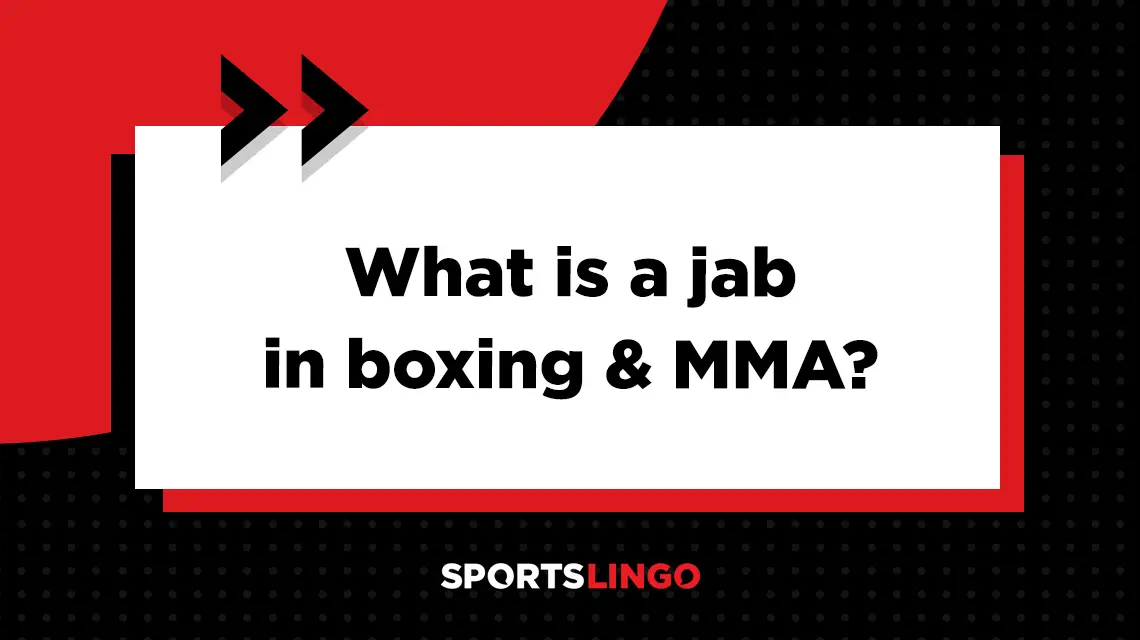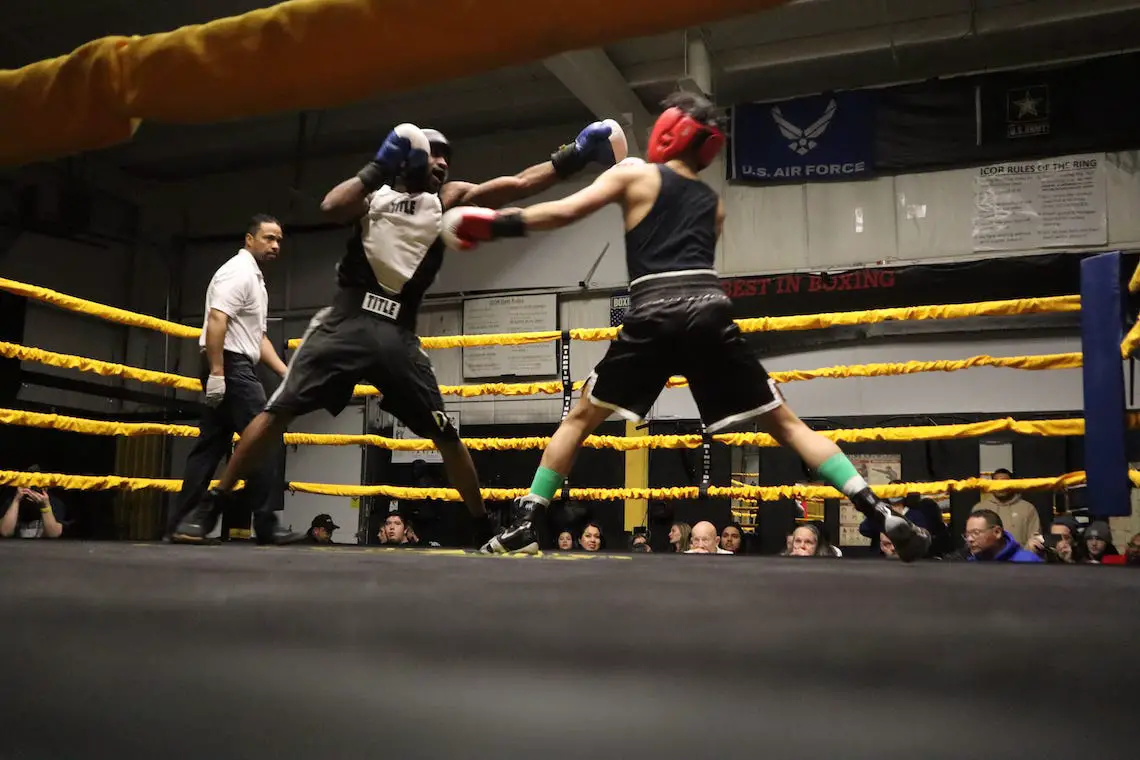
jab
What is the definition of jab in boxing and MMA?
1. A jab is a type of quick punch that is used in boxing, MMA and other combat sports. A jab is when the fighter throws a fast, straight punch that starts from their chin and hits the target that is in a direct line in front of them.
A jab is the most common and frequently used type of punch in a boxing match.
What is the meaning of the word “jab” in boxing and mixed martial arts?
A jab is one of the basic punches used in boxing and MMA. In this type of punch, the fighter’s lead hand moves straight ahead until the arm is fully extended from the side of the torso. Once the target is hit, the fighter snaps their fist back.
Because it is thrown so quickly, the jab can potentially catch opponents off guard. It doesn’t require an excessive amount of the fighter’s energy to execute a jab, yet it still has enough power and force to make an impact on the opponent.
What is the word for a punch with the fist?
There are several types of fist punches in boxing and other combat sports. The four main categories of punches are:
- Jab: The jab is a fast, straight punch with the lead hand that travels in a straight line to reach the target. It is one of the most basic punches in boxing and MMA.
- Cross: A cross is a straight punch with the rear hand. The fighter’s fist crosses their body to travel toward the target.
- Hook: A hook is a rear or lead hand punch that is thrown in an arced path from the fighter’s side. A hook can target the head or torso of an opponent.
- Uppercut: An uppercut is a vertical, rising punch with the lead or rear hand. The uppercut is considered a power punch because it packs so much force.
These punches are used across a variety of combat sports, including boxing, kickboxing, karate, muay Thai, and mixed martial arts. Within each of these four categories, there are a number of specific kinds of punches.
What’s the difference between a jab and a punch?
In boxing, a jab is a type of punch. So all jabs are punches, but all punches are not jabs. Other common boxing punches include hooks, crosses and uppercuts.
What’s the difference between a jab and a cross?
A jab is a quick hit with the lead hand, while a cross is a punch with the rear hand. Because of the way the fighter’s body moves while executing a cross, this type of hit is typically more powerful than a jab. However, a cross can leave a fighter more vulnerable to a counterpunch, whereas a jab doesn’t leave the fighter as exposed to an attack.
What is 1-2-3-4 in boxing?
In boxing, punches are coded using this numbering system:
- Jab
- Cross
- Lead hook
- Rear hook
- Lead uppercut
- Rear uppercut
Punching combinations are often described using these numbers. Therefore, a 1-2-3-4 in boxing refers to a jab, cross, lead hook and rear hook thrown in succession.

Andy Abeyta/USA TODAY Sports
How many types of jabs are there in boxing?
There are many different kinds of boxing jabs which can be applied in the sport. Some of the most commonly used jabs include:
- Speed jab: Due the speed jab’s quick thrust and mobility, a fighter will throw many of these punches in order to score points in a bout.
- Defense jab: A defense jab is used to help keep an opponent at a respectable distance. Because of its speed and power, this type of jab can help prevent the opponent from charging into the fighter. The jab can also be effectively thrown while the fighter is stepping backwards.
- Range-finding jab: At times, a fighter will throw a range-finding jab to help correctly gauge how far away their opponent is before they throw more jabs or harder punches.
- Power jab: Although the power jab is used primarily as a speed punch, a fighter may also use a this move to attack their opponent. The power jab is different than the speed jab, as it requires moving the fighter’s weight to their front, lead foot when delivering the punch. The fighter can generate even more power from their hips and from pushing off their back foot.
- Jab to the body: A jab to the body occurs when the fighter bends their waist in order to deliver a jab to the midsection of their opponent. However, this kind of jab makes the fighter more exposed to a counterpunch, so it must be executed strategically.
- Jab combinations: Jab combinations refer to the different punch sequences a fighter will use in a match. When fighter throws a series of punches without planning in order to score points, they typically finish their combination with a jab to avoid a counterpunch. Jab combinations may be used as a setup where the fighter throws the punch in order to move in closer to their opponent.
Is the jab the most important punch in boxing?
Many athletes and coaches maintain that the jab is the most important boxing punch. It’s often the first type of punch that beginners learn, and it’s important for competitive boxers to master the jab in order to defeat their opponents.
Is the jab the weakest punch?
Jabs are executed with a fighter’s non-dominant hand, so they generally aren’t as strong as those thrown with the dominant hand. Furthermore, some jabs are intentionally light because they’re done to intimidate or distract an opponent or to measure distance.
Although the jab isn’t as powerful as some other types of boxing punches, it’s an essential tactic for both offense and defense. Obviously, hitting an opponent with a well-placed jab can be a good offensive move. However, defensive jabs can also be useful in the ring. For example, a series of light jabs can help create distance from an opponent while allowing the fighter some time to conserve their energy before a more forceful attack.
Can you win a fight with a jab in MMA or boxing?
A strong, well-timed jab can potentially win a boxing or MMA match. In some bouts, jabs account for a majority of the punches thrown. The final, match-winning hit could be a jab depending on the circumstances and the skill level of the fighters involved.
Can a jab knock you out?
Because the jab is not known as a power punch, it is less likely to cause a knockout compared to crosses or uppercuts. However, a well-placed jab on a tired or dazed opponent could potentially cause a knockout.
How do you throw a perfect jab?
To throw the perfect jab, start by assuming the right boxing stance. Your feet should be about shoulder width apart with the knees slightly bent. Your lead foot and hand should be forward, so your body is slightly angled toward the opponent. Your fists should be up near your temples to protect your head, with your elbows bent and tucked in toward your sides.
To execute the jab, extend your lead hand straight forward from your shoulder. Rotate your body slightly to add more power to the punch. As your arm extends, your fist should rotate so that the hit lands with your palm facing down. Snap your leading hand back as soon as the jab lands and return to your original boxing stance.
Remember that your lead hand is your non-dominant hand. If you are left-handed, your right hand is your lead hand, and vice versa.

Raven Moore/USA TODAY Sports
Who threw the best jabs in boxing history?
Some of the boxers who mastered the jab during their careers include:
- Sonny Liston: Liston was known for the exceptional power of his jabs, with many noting that his jabs often seemed just as strong as punches thrown with his dominant hand.
- Muhammad Ali: Ali’s jabs are noted for their impressive speed and accuracy. His quickness would often catch his opponents off guard.
- Marvelous Marvin Hagler: Hagler’s left jab and left hook were remarkably powerful. He was trained as a southpaw despite being right-handed, so his jabs were unusually strong.
What does jab mean outside of sports?
The definition of jab is slightly different in contexts outside of boxing, MMA and other combat sports. The thesaurus synonyms for jab include:
- To poke or prod something, usually with a stick or other pointed object
- To tease or make fun of someone in a mocking way
- A colloquial term for an injection, as in “the flu jab” referring to an influenza vaccine shot
Where does the word “jab” come from?
The etymology of the word “jab” dates back to 1825. Originally, it was a Scottish variant of the word “job.” In this context, “jab” meant to pierce or strike something.
Examples of how jab is used in commentary
1. Mayweather keeps his opponent off balance by throwing a constant supply of jabs to his head.